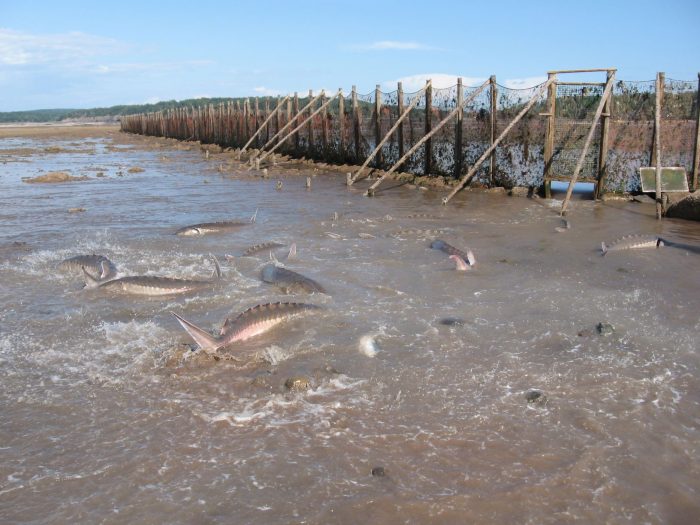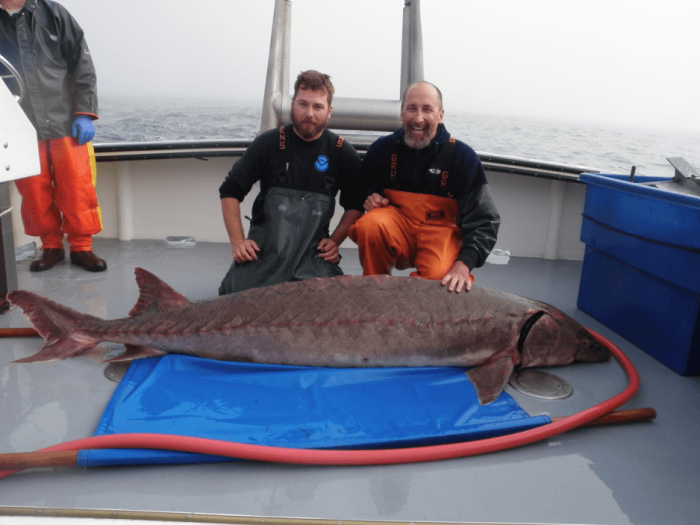
There are between 25 and 27 species of sturgeons in the temperate waters of the Northern hemisphere, and populations in all are depleted or threatened with extirpation because of overharvesting and habitat alteration. Atlantic sturgeon Acipenser oxyrinchus oxyrinchus was at one time distributed on both sides of the Atlantic Ocean, but the last European populations in the Baltic were believed extirpated in the 1960s. Atlantic sturgeon are anadromous, historically spawned in 38 rivers along the North American Atlantic Coast from the St. Lawrence River, Canada to the St. Marys River on Florida-Georgia border, but today spawning is confirmed in only 19 of these rivers and suspected in another six. All populations were severely depleted at the end of the 19th century because of rampant overharvest due to the caviar rage and, in more recent times, by the construction of dams which often precluded access to upriver spawning locales.
Public concern for the rebuilding of populations in part stems from the enormous size of specimens (up to 800 lbs in weight and 14 ft in length), their longevity (up to 60 years), and their prehistoric presence during the Cretaceous period about 120 million years ago. Atlantic sturgeon populations were listed as “endangered” or “threatened” in the U.S. under the Endangered Species Act (ESA) in 2012 and as “threatened” in Canada in 2011 by the Committee on the Status of Endangered Wildlife in Canada (COSEWIC). Genetic characterization of Atlantic sturgeon populations has served as a foundation for how the species is federally managed in the U.S. under the ESA. As a result, Atlantic sturgeon is listed and managed as five Distinct Population Segments (DPS). Each DPS was demonstrated to be genetically distinct and considered to constitute a significant unit within the species’ distribution. There are multiple known and perhaps yet to be discovered spawning populations within each DPS. The contemporary status of population abundances varies greatly and therefore some populations and DPS require greater protection from anthropogenic threats than others.
Juvenile Atlantic sturgeon are restricted to their natal estuaries for 2-6 years, after which subadults and adults are highly migratory, exhibiting long-range and prolonged movements in coastal waters to marine locales and non-natal estuaries distant from their natal rivers where they form aggregations of mixed population origin and where they may be vulnerable to anthropogenic threats. Adults only return to their natal rivers to spawn at ages ranging from 9-25 years depending on their population of origin. Effective management dictates that the relative contributions of each DPS and population to mixed aggregations in coastal waters and non-natal estuaries be determined.

Fig. 2. Bycatch of subadult and adult Atlantic sturgeon in a fish weir on mudflats in the Minas Basin of the inner Bay of Fundy, Nova Scotia, Canada (image courtesy of Mike Dadswell)
Atlantic sturgeon exhibit high homing fidelity to their natal rivers. Mitochondrial DNA sequence and microsatellite DNA polymorphisms provide inherent genetic tags that have been used to characterize individual spawning populations of Atlantic sturgeon, define their genetic population structure, and estimate their evolutionary relationships. These genetic polymorphisms have also been used to quantify the proportion of each spawning population in mixed aggregations using Mixed Stock Analysis (MSA) and to determine the population origin of individual specimens with Individual-Based Assignment (IBA) testing.
The successful use of this approach requires that the DNA profiles of individual spawning populations contributing to mixed aggregations be determined using specimens that are assuredly natal to the rivers in which they were collected, i.e. pre-migratory juveniles and spawning adults. The same genetic markers are then interrogated in specimens from mixed aggregations and are statistically compared to those of the reference spawning populations. Two prerequisites to successful use of this approach should be noted. First, spawning populations must be genetically distinct, the greater the genetic differences among populations the greater the accuracy of the MSA and IBA estimates. Second, most, if not all, spawning populations contributing to mixed aggregations should be characterized.
We used this genetic approach in several studies to estimate the contributions of individual spawning populations and DPS to mixed aggregations of Atlantic sturgeon that are vulnerable to known anthropogenic disturbances. For example, it is known that bycatch of Atlantic sturgeon in U.S. coastal fisheries is substantial and that mortality in some types of gear may be high (up to 20% for sink gill nets). In fact, it has been hypothesized that bycatch mortality is the major reason for the continued decline of some populations and the failure of others to rebuild. Thus, it was important to quantify the susceptibility of individual populations and DPS to overall coastal bycatch and interactions with different gear types.
In response, we evaluated the relative contributions of individual populations and DPS to bycatch of Atlantic sturgeon in marine waters from Maine to North Carolina (Wirgin et al. 2015a). We found that the Hudson River, New York, population was the greatest contributor to coastal bycatch (42% to 46%) and suffered the highest frequency of mortalities (48%) in encounters with sink gill nets. Furthermore, it was learned that some specimens, particularly those from populations in the South Atlantic DPS, moved great distances prior to their coastal bycatch.

Fig. 3. Adult Atlantic sturgeon (118 kg) collected off the Delaware Coast by prominent sturgeon researchers Drs. Dewayne Fox and Matt Breece, with an anchor gill net in April 2012. A fin clip was taken for DNA analysis and the specimen was implanted with an acoustic transmitter to monitor its coastal movements. This activity was conducted pursuant to NMFS permit 16507 (image courtesy of Delaware State University)
Large numbers of subadult and adult Atlantic sturgeon are known to occur during the warmer months in the Minas Basin of the inner Bay of Fundy (Stewart et al. 2017). This aggregation is potentially susceptible to mortality from movement up the Annapolis River, a tributary of the Bay, and passage through the existing tidal turbine at the Annapolis Generating Station and in the future from the proposed deployment of hydrokinetic turbines in the northern portion of the Minas Passage. Additionally, moderate numbers of stranded Atlantic sturgeon have been detected in proximity to intertidal fish weirs sited in the mudflats of the Minas Basin. The origin of specimens in the Bay of Fundy is of international importance because of their federal protection in both countries and their potential ancestry in both Canadian and U.S. spawning rivers.
Using the DNA-based approach, we determined that 61%-63% of specimens collected from weirs and trawling in the Minas Basin were of Saint John River, New Brunswick origin, 34%-35% from the Kennebec River, Maine, and 1-2% from the Hudson River (Wirgin et al.2012). Thus, substantial numbers of specimens from both countries would likely be impacted by current and future sources of mortality within the Bay of Fundy.
It is likely that at one time the Connecticut River hosted spawning of Atlantic sturgeon, but none was detected for over a century. The Connecticut River is a tributary of the Long Island Sound and the Hudson River is the most proximal spawning river to its mouth. Using the DNA-based approach, we demonstrated that the Hudson River was the major contributor to aggregations of subadult Atlantic sturgeon in the Long Island Sound and Connecticut River that were collected over several decades (Waldman et al. 2013). However, for the first time, surveys that had been conducted for decades revealed the presence of moderate numbers of one-year-old Atlantic sturgeon in the Connecticut River in 2014, an age at which they were almost certainly spawned within that river. Surprisingly, DNA-based analysis indicated that the colonists that produced these juvenile offspring were not of Hudson River origin, but instead were primarily of South Atlantic and Chesapeake Bay DPS ancestry (Savoy et al. 2017).
Subadult Atlantic sturgeon are known to seasonally wander far from their natal estuaries, sometimes to other estuaries that do and don’t host their own spawning populations. These estuaries may present anthropogenic threats to migrating subadults that are not found in their natal estuaries. The Hudson River hosts the largest population of Atlantic sturgeon coastwide, but it also poses acute and chronic threats to sturgeons including vessel strikes and chemical contaminants. Using the DNA-based approach, we investigated the population and DPS origin of subadult Atlantic sturgeon in the tidal Hudson River (Wirgin et al. 2018). As expected, greater than 90% of subadults assigned to the Hudson River, including all dead specimens that had been severed by ship strikes, however, small numbers of specimens assigned to populations distant from the New York Bight DPS including the Kennebec River, Maine (Gulf of Maine DPS) and the Ogeechee River, Georgia (South Atlantic DPS). This study confirmed that subadult Atlantic sturgeon are potentially vulnerable to anthropogenic threats in estuaries other than those in which they were spawned.
MSA and IBA are proven valuable approaches used by resource managers to accurately identify the DPS and population origin of individual subadult and adult Atlantic sturgeon collected outside of their natal estuaries and in quantifying their relative contributions to mixed aggregations. This information is invaluable in conservation efforts to minimize the detrimental effects of anthropogenic disturbances on the most vulnerable of populations and DPS. The mean accuracy of assignments to the DPS level has been very high at 97%. The mean accuracy of assignments at the population level has been lower at 86% with the highest percentage of misassignments occurring among populations in the South Atlantic DPS where the magnitude of genetic differentiation among populations is lower than elsewhere.
One caveat to results reported to date is the likely absence from the reference collections of some smaller contemporary spawning populations. For example, the York River, Virginia, which recently was shown to host a genetically distinct, small spawning population (Hager et al. 2014), was not included among the reference collections in the MSA and IBA studies reported to date. Given the scarcity and cryptic nature of young life-stages and absence of adults from spawning rivers for decades, it is likely that additional populations have yet to be rediscovered and sampled.
References:
- Hager, C., Kahn, J., Watterson, C., Russo, J., and Hartman, K., 2014. Evidence of Atlantic sturgeon spawning in the York River system. Transactions of the American Fisheries Society 143: 1217-1219.
- Savoy, T., Maceda, L., Roy, N.K., Peterson, D., and Wirgin, I., 2017. Evidence of natural reproduction of Atlantic Sturgeon in the Connecticut River from unlikely sources. PlosOne, https://journals.plos.org/plosone/article?id=10.1371/journal.pone.0175085.
- Stewart, N.D., Cormier, Y., Logan-Chesney, L.M., Gibson, G., Wirgin, I., Dadswell, M.J., and Stokesbury, M.J.W., 2017. Stranding of Atlantic sturgeon Acipenser oxyrinchus oxyrinchus in Scot’s Bay, Bay of Fundy, Nova Scotia, from populations of concern in the United States and Canada. Journal of Applied Ichthyology, 2017: 1-6.
- Waldman, J.R., King, T., Savoy, T., Maceda, L., Grunwald, C. and Wirgin, I., 2013. Stock origins of subadult and adult Atlantic sturgeon, Acipenser oxyrinchus, in a non-natal estuary, Long Island Sound. Estuaries and Coasts, 36: 257-267.
- Wirgin, I., Breece, M.W., Fox, D.A., Maceda, L., Wark, K.W., and King, T., 2015b. Origin of Atlantic sturgeon Acipenser oxyrinchus collected off the Delaware Coast during Spring Months. North American Journal of Fisheries Management, 35: 20-30.
- Wirgin, I. Maceda, L, Grunwald, C., and King, T., 2015a. Population origin of Atlantic sturgeon bycaught in U.S. Atlantic Coast fisheries. Journal of Fish Biology, 85: 1251-1270.
- Wirgin, I., Maceda, L., Waldman, J.R., Wehrell, S., Dadswell, M., and King, T., 2012. Stock origin of migratory Atlantic sturgeon in the Minas Basin, Inner Bay of Fundy, Canada, determined by microsatellite and mitochondrial DNA analyses. Transactions of the American Fisheries Society, 141: 1389-1398.
- Wirgin, I., Roy, N.K, Maceda, L., and Mattson, M., 2018. DPS and population origin of subadult Atlantic Sturgeon in the Hudson River. Fisheries Research, 207: 165-170.









